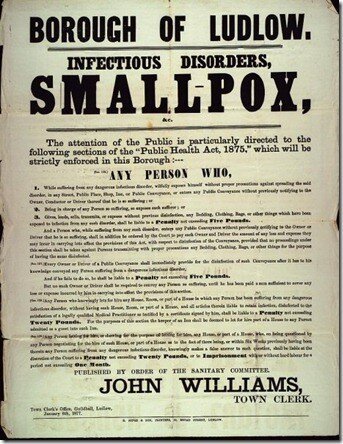The lane from Throwleigh to to Acre Cottage
by Colin Burbidge
On December 19th, 1893, the “Western Times” reported an outbreak of smallpox at Throwleigh. The Medical Officer of Health for the Okehampton Sanitary Authority, Dr. Young said there were two serious cases of smallpox. It had occurred in a small cottage 500 yards from the village and 100 yards from the main road. It appeared that a boy from a nearby village had brought the disease. In addition to the two persons with the disease, there were four more people in the house. They had been exposed to the contagion, and it would be unwise for them to go about the parish. He proposed they be isolated for a fortnight., and a nurse would be procured to attend the patients. Dr. Young said notices should be posted around the village warning of the outbreak. Dr. Young said the outbreak was serious and probably more cases would be reported. Mr. Hooper (the Sanitary Inspector) left that afternoon for Throwleigh with bedding etc, and other things necessary to deal with the cases.
On January 1st, 1894 Dr. Young reported to the authority that he had been unable to trace the infection further back than the boy who took the disease to Acre Cottage. A further two cases had occurred, however they were both of a mild type. The cases at Acre Cottage were now convalescent. He suggested handbills advising re-vaccination to be posted about the district.
The Board unanimously adopted the recommendation of the Medical Officer.
On March 16th, the “Western Times” reported Dr. Young as saying one of the Throwleigh patients had fatally succumbed to the disease and it was too early to say they were “out of the woods”. The healthy persons living in the infected houses deserved some praise for submitting to more or less complete imprisonment, which they cheerfully underwent.
He acknowledged the help received from Mr. Dunning the Guardian of Throwleigh Parish, and Dr. Hunt the District Medical Officer, had it not been for their endeavours he was sure the spread would have been more extensive.
On the 30th of March 1894, the “Western Times” reported that no fresh cases of smallpox had occurred at Throwleigh or been notified for over 2 months, and Dr. Young considered they were now quite free from any further risk. All infected houses had been disinfected and the bedding etc, destroyed.
Footnote.
In 1898 a new Vaccination Act introduced a clause allowing people to opt out for moral reasons - the first time "conscientious objection" was recognised in UK law.
Opposition to vaccinations has endured despite overwhelming medical evidence of their success.
In 1899, notification of various infectious diseases, including smallpox, became compulsory.
As the use of vaccines spread - along with improved sanitation - smallpox was pushed out of Europe and North America.
Apart from a death, (linked to a Birmingham laboratory) the last case was recorded in Somalia in 1977.

